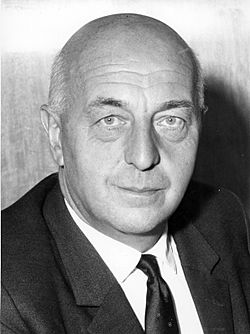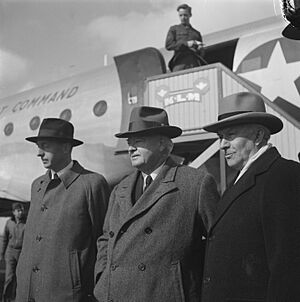Sicco Mansholt facts for kids
Quick facts for kids
Sicco Mansholt
|
|
|---|---|

Mansholt in 1962
|
|
| President of the European Commission | |
| In office 22 March 1972 – 5 January 1973 |
|
| Vice President | Wilhelm Haferkamp |
| Preceded by | Franco Maria Malfatti |
| Succeeded by | François-Xavier Ortoli |
| First Vice-President of the European Commission |
|
| In office 7 January 1958 – 22 March 1972 |
|
| President |
See list
|
| Preceded by | Office established |
| Succeeded by | Wilhelm Haferkamp |
| European Commissioner for Agriculture | |
| In office 7 January 1958 – 22 March 1972 |
|
| President |
See list
|
| Preceded by | Office established |
| Succeeded by | Carlo Scarascia-Mugnozza |
| Minister of Economic Affairs | |
| In office 14 January 1948 – 20 January 1948 Ad interim |
|
| Prime Minister | Louis Beel |
| Preceded by | Gerardus Huysmans |
| Succeeded by | Jan van den Brink |
| Member of the House of Representatives | |
| In office 3 July 1956 – 3 October 1956 |
|
| In office 15 July 1952 – 7 September 1952 |
|
| In office 27 July 1948 – 10 August 1948 |
|
| In office 4 June 1946 – 18 July 1946 |
|
| Parliamentary group | Labour Party |
| Minister of Agriculture, Fisheries and Food Supplies |
|
| In office 25 June 1945 – 1 January 1958 |
|
| Prime Minister |
See list
|
| Preceded by | Hans Gispen as Minister of Commerce, Industry and Agriculture Jim de Booy as Minister of Shipping |
| Succeeded by | Kees Staf (Ad interim) |
| Mayor of Wieringermeer | |
| In office 30 April 1945 – 22 May 1945 Ad interim |
|
| Preceded by | Aris Saal |
| Succeeded by | Gerrit Gesenius Loggers |
| Personal details | |
| Born |
Sicco Leendert Mansholt
13 September 1908 Ulrum, Netherlands |
| Died | 29 June 1995 (aged 86) Wapserveen, Netherlands |
| Political party | Labour Party (from 1946) |
| Other political affiliations |
Social Democratic Workers' Party (1937–1946) |
| Spouse |
Henny Postel
(m. 1938) |
| Children | 2 sons and 2 daughters |
| Alma mater | National Higher Agricultural School (Bachelor of Science in Agriculture) |
| Occupation | Politician · Diplomat · Civil servant · Agronomist · Farmer · Lobbyist |
Sicco Leendert Mansholt (born September 13, 1908 – died June 29, 1995) was a Dutch farmer and a very important politician. He was a member of the Social Democratic Workers' Party and later the Labour Party. He is best known for being the President of the European Commission from 1972 to 1973.
Mansholt worked as a farmer in Wieringermeer from 1937 to 1945. During World War II, he joined the Dutch resistance to fight against the German occupation. He helped hide people who were in danger.
After the war, Mansholt became the acting Mayor of Wieringermeer for a short time. He then became the Minister of Agriculture, Fisheries and Food Supplies in the Dutch government in 1945. He was also elected as a Member of the House of Representatives. He served as Minister of Agriculture for many years, helping to shape farming policies in the Netherlands.
In 1958, Mansholt became one of the first European Commissioners from the Netherlands. He was the Commissioner for Agriculture and also a Vice-President. He worked to modernize farming across Europe. In 1972, he became the President of the European Commission. During his time as President, the European Monetary System was created, and the European Union grew to include more countries.
Sicco Mansholt is remembered as one of the people who helped create the European Union. He was known for being a good negotiator and manager. He was the longest-serving Minister of Agriculture in the Netherlands and the only Dutchman to become President of the European Commission.
Contents
Early Life and Education
Sicco Leendert Mansholt was born on September 13, 1908, in Ulrum, a town in the Groningen province of the Netherlands.
His family were farmers and also socialists. His father and grandfather supported early socialist leaders. His mother, Wabien Andreae, was one of the first women to study Political Science. She organized political meetings for women in their homes.
Sicco grew up with two brothers and two sisters in a large house called "Huis ter Aa." He went to school in Groningen and then studied to become a tobacco farmer at the School of Tropical Agriculture in Deventer.
Farming Career
After his studies, Mansholt moved to Java in the Dutch East Indies (which is now Indonesia). There, he started working on a tea plantation.
He returned to the Netherlands in 1936 because he was not happy with the colonial system. He wanted to be a farmer in his home country. He moved to the Wieringermeer, which was a new piece of land reclaimed from the sea in 1937. He started his own farm there.
In 1938, he married Henny J. Postel. They had two sons and two daughters.
During World War II, Mansholt was an active member of the Dutch resistance. He helped people who were in danger hide in the Wieringermeerpolder. He also helped organize secret food distributions for people in the western parts of the Netherlands.

Political Journey
Local Politics
Mansholt joined the Social Democratic Workers' Party (SDAP) in 1937. He became a secretary for the local party. He held several public roles for the SDAP in Wieringermeer, including acting mayor for a short time.
Minister of Agriculture
Right after World War II, in June 1945, the Prime Minister asked Mansholt to become the Minister of Agriculture, Fishery, and Food Distribution. He was only 36 years old, making him the youngest member of the government at that time.
He served as a minister in six different governments. As Minister of Agriculture, he was very important in creating the Common Agricultural Policy for the European Community. This policy helped shape farming across Europe. Mansholt was so dedicated to his work, but also enjoyed life. In 1954, a debate about the agriculture budget was postponed because he was ice-skating in the famous 200-kilometer Elfstedentocht race in Friesland. He skated this race twice in his life!
European Commission
In 1958, Mansholt became one of the first Commissioners for the new European Commission. He was the Commissioner for Agriculture and also a Vice-President of the organization. He worked to modernize farming methods across Europe.
He became the President of the European Commission on March 22, 1972. He stayed in this position until January 5, 1973. During this time, he was influenced by the ideas of the Club of Rome, which focused on global challenges like population growth and resource limits.
Life After Politics
After he retired from politics, Mansholt published his autobiography called De Crisis ("The Crisis") in 1974.
He spent his last years living on an old farm in the quiet village of Wapserveen. He passed away there on June 29, 1995. His daughter Lideke also died in 1995, at the age of 53.
Awards and Honors
Sicco Mansholt received many awards and honors for his work and service.
Military Decorations
- Resistance Memorial Cross (Netherlands, 1982) - This award recognized his brave actions in the Dutch resistance during World War II.
Honors
- Grand Cross of the Order of the Oak Crown (Luxembourg, 1957)
- Knight Grand Cross of the Order of Orange-Nassau (Netherlands, 1958)
- Grand Cross of the Order of the Crown (Belgium, 1968)
- Commander of the Order of Agricultural Merit (France, 1970)
- Grand Cross of the Order of Merit (Germany, 1972)
- Knight Grand Cross of the Order of the Netherlands Lion (Netherlands, 1972)
- Grand Cross of the Legion of Honour (France, 1973)
Honorary Degrees
- Wageningen University (Netherlands, 1956) - He received an honorary degree in Agronomy, which is the science of soil management and crop production.
See also
 In Spanish: Sicco Mansholt para niños
In Spanish: Sicco Mansholt para niños

